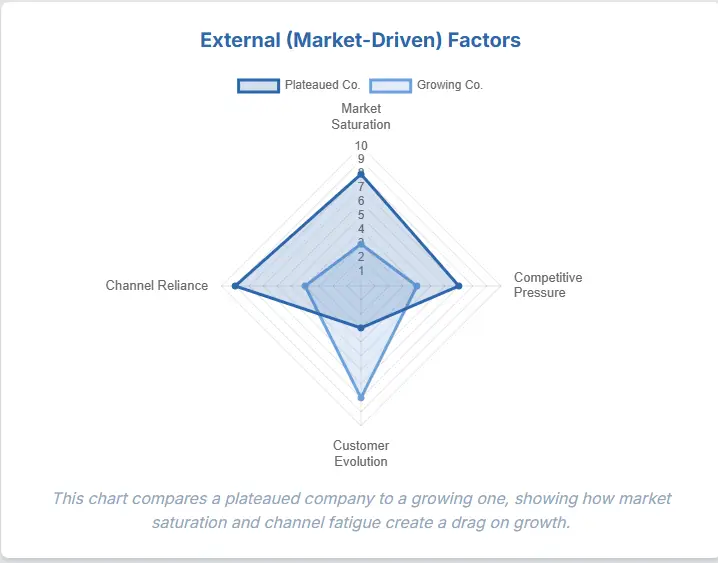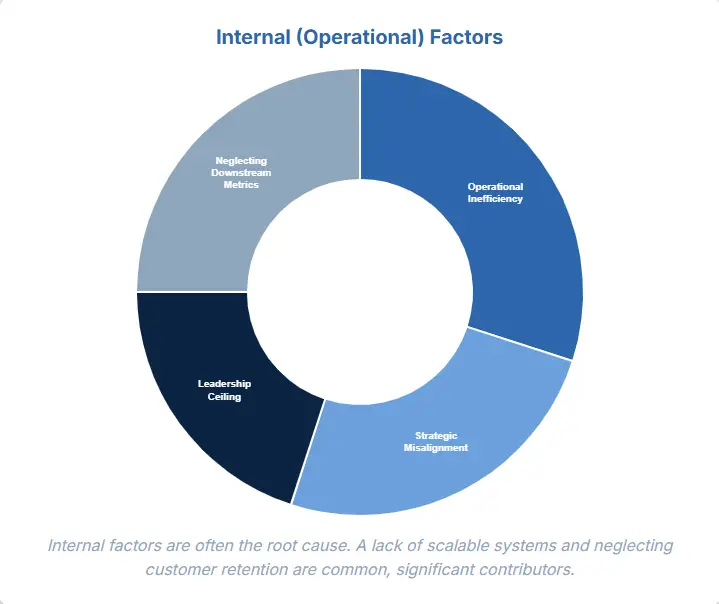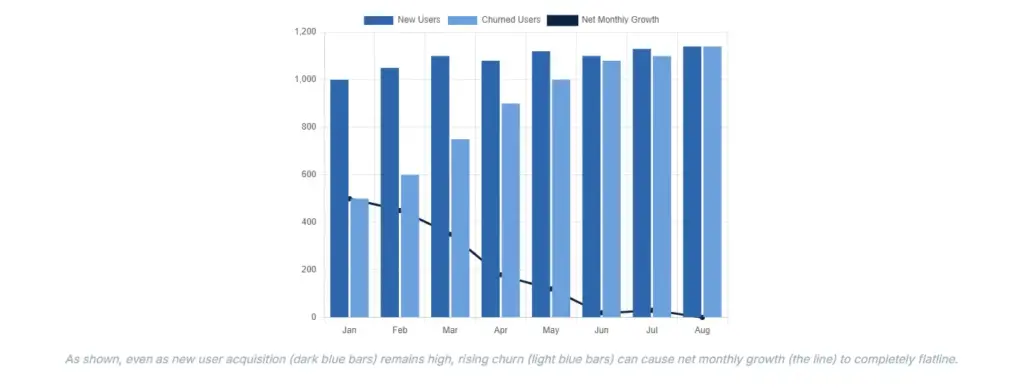When growth slows down
In the early stages of running a business, things often move quickly. Sales go up, new customers come in, and the team feels excited. But after a few years, usually around year two to five, this steady growth can slow down.
This is known as a growth plateau.
A plateau happens when the usual ways of growing, like online ads, word of mouth, or just working harder, don’t lead to better results anymore. Sales stay flat. New customer leads are becoming fewer. The team feels like they’re putting in effort but not seeing progress. This can be frustrating, but it’s also a common stage many businesses go through.
The growth gap: expectation vs. reality
Many business owners think growth will keep going up smoothly, maybe even very quickly. But studies show something different.
- In a study of over 140,000 startups, many founders believed they would grow revenue by 500% in their first year. Most of them didn’t make more than that first-year revenue even five years later
- Less than 10% of small businesses reach £1 million in yearly revenue
- Even companies with strong funding and early success often slow down after their first big push.
This difference between what people hope for and what really happens is sometimes called the “growth gap.” The business grows well for a while, then it stops moving forward.

In our own work, we’ve seen this happen in different ways. Some businesses miss their goals again and again. Others notice that each new campaign or idea brings in less than before. Teams start to focus on quick fixes rather than long-term plans.
This stage can surprise many leaders. Early wins can make it seem like things will always keep moving, which makes it hard to see when it’s time to make bigger changes.
To help show this idea, we’ve included a simple chart:

It shows a path many businesses follow, early growth, then a slowdown in the middle, and with the right changes, a chance to grow again.
Diagnosing the stall: external and internal root causes
When growth slows down, there’s usually more than one reason. It often comes from a mix of outside challenges and inside roadblocks. A drop in leads or a rise in ad prices might seem like the problem, but these things are often just signs of something deeper.
Here are some of the usual causes:
External factors (market)
- Market saturation: The easiest customers have already signed up. Getting new ones now takes more time, effort, and money.
- More competition: Other businesses enter the market with similar offers or lower prices. It becomes harder to stand out, and the cost to get new customers (called CAC – Customer Acquisition Cost) goes up.
- Changing customer needs: What people wanted before might not be what they want now. Even small shifts can make a product or service feel outdated.
- Tired channels: If most growth came from one place, like social media ads or word of mouth, it may not work as well anymore. People get used to it, and results drop.

Internal factors (operations and leadership)
- Slow processes: Systems that worked at the beginning may now be too messy or too slow. Manual tasks, unclear roles, or no clear process can cause delays.
- Too much reliance on the founder: When one person makes most decisions or holds key relationships, things slow down when that person gets too busy.
- Lack of clear direction: Without a clear plan, teams start reacting to problems instead of planning ahead. Messages become confusing. Team spirit drops.
- Customer drop-off: When all the focus is on getting new customers, it’s easy to miss issues with current ones. Poor support or confusing onboarding can make customers leave without saying much.

These causes can be hard to see. Meetings are still happening. Revenue may look steady. But inside, things feel stuck. Progress slows, teams feel tired, and leaders spend more time solving problems than moving forward.
This kind of situation can happen in many types of businesses. A software company might grow fast with new users but struggle to keep them. A service business might find its old way of working can’t handle new demand. Often, the problems only become clear when everything feels heavy and progress stops.
The leaky bucket effect
Sometimes, even when a business is working hard to bring in new customers, the total number of customers doesn’t grow. This can happen because people are leaving at the same time new ones arrive. It’s like filling a bucket with holes in it; water goes in, but it also leaks out.
This kind of drop-off, called “churn, ” can be hard to notice at first. If you’re not looking closely at things like how customers start using your service, how quickly they get help, or whether they’re getting value, the signs can slip by. The money coming in might look steady, but the team can feel like every win is harder than the last. It can feel like there are small problems behind the scenes that are growing bigger.

This also affects how the team feels. Marketing might be asked to keep bringing in new leads, while the support team is busy fixing problems that customers don’t always talk about clearly. Leaders might think they need more customers when, actually, the issue is that the ones they already have are slowly leaving.
When customers leave, it doesn’t always happen loudly. They may stop replying to emails, delay payments, or use the service less. This slow fade can be just as serious as someone clearly saying they’re unhappy. And it can cost the business both money and energy.
Some businesses believe they have a problem finding leads, when really, they have a problem keeping the customers they already have. Until this is looked at properly, the business might feel like it’s always running just to stay in place.
Breaking through the plateau
Getting back to steady growth after things slow down doesn’t usually happen by just working harder. Many businesses only start to move forward again when they stop and look closely at what’s changed, both inside the business and in the outside world. This often means looking again at the systems and habits that guide how things get done, rather than just adding more new tasks.

Here are three helpful steps seen in case studies and research:
1. Look at your customer groups and messaging again
- Try to find smaller customer groups that are easier to reach or stay longer
- Update your messages to better fit what customers want now
- Think about changing your prices or offering new pricing levels
Sometimes businesses slow down because they’ve already reached most of the people in their original market. Looking at different customer groups or adjusting your message can help find new opportunities. You may not need to switch to a new industry, just understand your current one better. This can bring better results without changing everything.
2. Improve the way things work inside the business
- Use tools to make repetitive tasks automatic
- Make it easier for new customers to get started and stay happy
- Write down clear steps and roles so everyone knows what to do
As a business grows, it can become harder to keep everything running smoothly. Systems that used to be quick can start to feel messy. Making things clearer and using tools to help with daily work can save time and reduce stress. This helps the team work better together and makes it easier to grow in a steady way.
3. Try new ways to grow
- Test one new way of finding customers
- Offer your services in a nearby market or to a different group of people
- Talk to an outside expert or join a group of other business owners
Sometimes, trying something new can open the door to new growth. You don’t have to stop what’s already working, but adding another way to grow can help. Getting fresh ideas from someone outside the business can also help spot things you might not have noticed.
These steps are not just small fixes, they often bring up bigger questions about how the business has been running. Businesses that take the time to look and adjust often find stronger and more lasting ways to grow.
A note from Serenichron
We often work with founders who are going through this stage in their business journey. It’s the point where plans don’t feel as clear, the usual tools don’t show what’s really going on, and there’s pressure to keep things moving without tiring out the team.
What we do is help make sense of what’s happening under the surface. Many business owners already have a sense that something needs to change, but it can be hard to explain or organise those thoughts. We help turn those feelings into a clearer picture so action becomes easier.
When a business hits a plateau, it’s usually because something has changed. The way things worked before no longer fits the business as it is now. Processes that felt quick and flexible might now feel messy or confusing. Getting things moving again often means looking at where time and effort go, what systems are in place, and whether old habits are still useful.
This article includes ideas based on research, our own work, and insights shared by other business owners and experts. We’ve looked at many sources to spot the patterns that come up again and again at this stage. These include:
- QuickBooks UK, Entrepreneur Magazine
- Research from JPMorgan Chase Institute on small business growth
- Ongoing studies from ITIF.org, Digile.com, and Salesforce on business development
- Practical advice from sites like Luisazhou.com and StartGrowImprove.com
Save this if you’re navigating a plateau.
Or send it to someone who might be.
If any part of this feels familiar, let’s talk.
About the Author
Vlad writes about automation, operations, and the little tweaks that make a big difference in how businesses run. A former game designer turned founder, he now helps teams fix broken workflows and spot the revenue leaks hiding in plain sight.
About Serenichron

Helping businesses grow by simplifying strategy, streamlining systems, and making tech actually work for people. We bring clarity to chaos with practical tools, honest guidance, and just enough curiosity to question the default way of doing things.